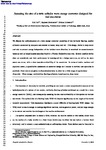Assessing the size of a twin-cylinder wave energy converter designed for real sea-states
| dc.contributor.author | Xu, D | |
| dc.contributor.author | Stuhlmeier, Raphael | |
| dc.contributor.author | Stiassnie, M | |
| dc.date.accessioned | 2018-03-07T09:27:27Z | |
| dc.date.available | 2018-03-07T09:27:27Z | |
| dc.date.issued | 2018-01-01 | |
| dc.identifier.issn | 0029-8018 | |
| dc.identifier.issn | 1873-5258 | |
| dc.identifier.other | C | |
| dc.identifier.uri | http://hdl.handle.net/10026.1/11002 | |
| dc.description | publisher: Elsevier articletitle: Assessing the size of a twin-cylinder wave energy converter designed for real sea-states journaltitle: Ocean Engineering articlelink: http://dx.doi.org/10.1016/j.oceaneng.2017.10.012 content_type: article copyright: © 2017 Elsevier Ltd. All rights reserved. | |
| dc.description.abstract |
We discuss the hydrodynamics of a wave energy converter consisting of two vertically floating, coaxial cylinders connected by dampers and allowed to heave, surge and pitch. This design, viable in deep water and able to extract energy independent of the incident wave direction, is examined for monochromatic waves as well as broad-banded seas described by a Pierson Moskowitz spectrum. Several possible device sizes are considered, and their performance is investigated for a design spectrum, as well as for more severe sea states, with a view towards survivability of the converters. In terms of device motions and captured power, a quantitative assessment of converter design as it relates to survival and operation is provided. Most results are given in dimensionless form to allow for a wide range of applications. | |
| dc.format.extent | 243-255 | |
| dc.language | en | |
| dc.language.iso | en | |
| dc.publisher | Elsevier | |
| dc.subject | Wave energy | |
| dc.subject | Survivability | |
| dc.subject | Floating cylinders | |
| dc.subject | Broad spectra | |
| dc.subject | Deep water | |
| dc.title | Assessing the size of a twin-cylinder wave energy converter designed for real sea-states | |
| dc.type | journal-article | |
| dc.type | Journal Article | |
| plymouth.author-url | https://www.webofscience.com/api/gateway?GWVersion=2&SrcApp=PARTNER_APP&SrcAuth=LinksAMR&KeyUT=WOS:000423649000020&DestLinkType=FullRecord&DestApp=ALL_WOS&UsrCustomerID=11bb513d99f797142bcfeffcc58ea008 | |
| plymouth.volume | 147 | |
| plymouth.publication-status | Published | |
| plymouth.journal | Ocean Engineering | |
| dc.identifier.doi | 10.1016/j.oceaneng.2017.10.012 | |
| plymouth.organisational-group | /Plymouth | |
| plymouth.organisational-group | /Plymouth/Faculty of Science and Engineering | |
| plymouth.organisational-group | /Plymouth/Faculty of Science and Engineering/School of Engineering, Computing and Mathematics | |
| plymouth.organisational-group | /Plymouth/REF 2021 Researchers by UoA | |
| plymouth.organisational-group | /Plymouth/REF 2021 Researchers by UoA/EXTENDED UoA 10 - Mathematical Sciences | |
| plymouth.organisational-group | /Plymouth/REF 2021 Researchers by UoA/UoA10 Mathematical Sciences | |
| plymouth.organisational-group | /Plymouth/Users by role | |
| plymouth.organisational-group | /Plymouth/Users by role/Academics | |
| plymouth.organisational-group | /Plymouth/Users by role/Researchers in ResearchFish submission | |
| dcterms.dateAccepted | 2017-10-11 | |
| dc.rights.embargodate | 2018-11-5 | |
| dc.identifier.eissn | 1873-5258 | |
| dc.rights.embargoperiod | Not known | |
| rioxxterms.versionofrecord | 10.1016/j.oceaneng.2017.10.012 | |
| rioxxterms.licenseref.uri | http://www.rioxx.net/licenses/all-rights-reserved | |
| rioxxterms.licenseref.startdate | 2018-01-01 | |
| rioxxterms.type | Journal Article/Review |


